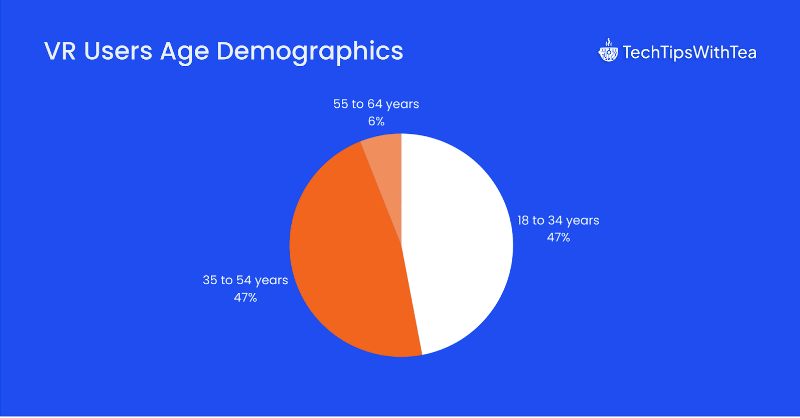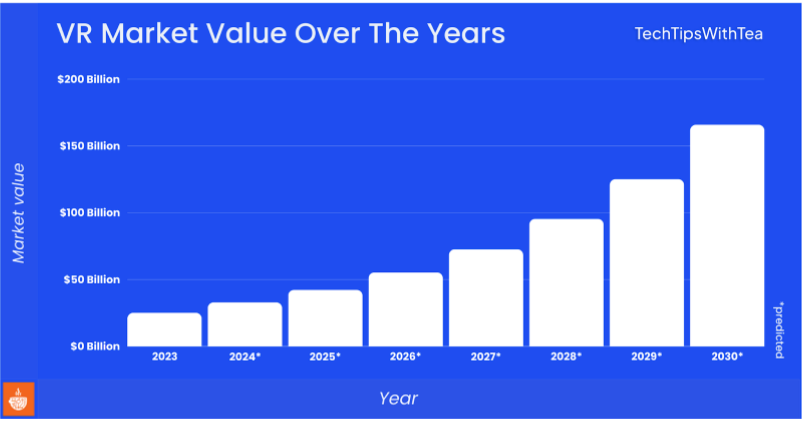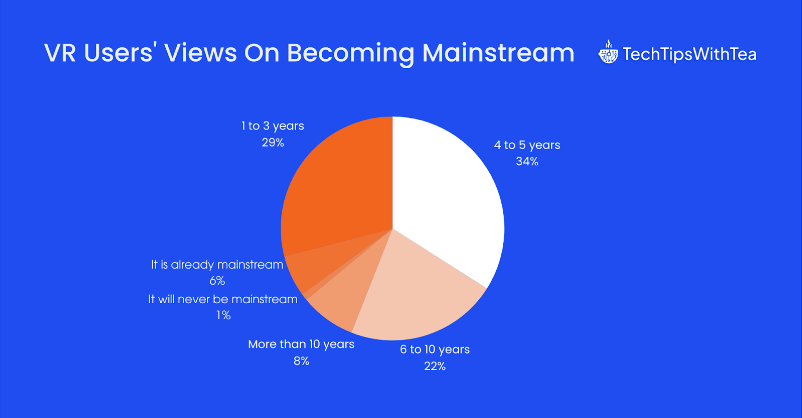Virtual reality is one of the fastest-growing trends in how we consume digital media. The immersive way of experiencing content has attracted millions of users to date.
People of all ages use VR, and the number of users and market value is set to grow explosively in the coming decade.
This article features the most crucial statistics revolving around VR users, usage, and market value.
Virtual Reality Statistics (Top Picks 2024)
- Over 171 million people use virtual reality.
- There are nearly 66 million VR users in the U.S. alone.
- The virtual reality market is expected to be worth $165.91 billion by 2030.
- 60% of VR users are men, and 40% are women.
- The U.S. VR software market will be worth $990.3 million in 2024.
Virtual Reality Users Statistics
With increased VR content creation in 2024, VR enthusiasts are growing rapidly.
Initially, the user base was mainly made up of gamers, but the scenario is changing, and people from every age and industry use VR for various purposes.
In this section, let us explore statistics about how many people use virtual reality.
More Than 171 Million People Use VR Globally
In 2014, only about 200,000 hardcore gamers were using virtual reality.
The number of VR users increased significantly over the next four years and reached over 171 million users in 2018.
About 114 million of them were part of the early majority of users; 41 million were light gamers, and 16 million were hardcore gamers.
Here is a table showing the growth of VR users over the years:
| Year | Total VR Users | Early Majority | Light Gamers | Hardcore Gamers |
|---|---|---|---|---|
| 2018 | 171 million | 114 million | 41 million | 16 million |
| 2017 | 90 million | 58 million | 23 million | 9 million |
| 2016 | 43 million | 26 million | 13 million | 4 million |
| 2015 | 6.7 million | 4.1 million | 1.6 million | 1 million |
| 2014 | 200,000 | — | — | — |
Source: Statista
The United States Has Nearly 66 Million VR Users
The number of virtual reality users in the United States has increased notably in recent years. VR users are distributed as headsets and non-headset users.
There were an estimated 32.7 million headset VR users and 33.2 million non-headset users in 2023.
The United States recorded more than 50.2 million VR users in 2020, which rose by over 15 million users, reaching over 65.9 million in 2023.
Comparatively, there are around 110 million AR users in the United States.
Here is a table showing the number of virtual reality users in the United States:
| Year | Total VR Users | VR Headset Users | Non-Headset Users |
|---|---|---|---|
| 2023 | 65.9 million | 32.7 million | 33.2 million |
| 2022 | 64 million | 31.3 million | 32.7 million |
| 2021 | 58.9 million | 28.3 million | 30.6 million |
| 2020 | 50.2 million | 22.2 million | 28 million |
| 2019 | 43.1 million | 20.8 million | 22.3 million |
| 2018 | 34.6 million | 15.6 million | 19 million |
| 2017 | 22.5 million | 11 million | 11.5 million |
Source: Statista
VR Users Demographics
VR users vary depending on their purpose, age, and gender, and the penetration of VR is expected to rise among Gen Z and Millennials.

This section will discuss the age and gender demographics of VR users.
Users Aged Between 18 And 34 Make Up 47% Of VR Users
The latest technology trends are adopted by Gen Z and Millennials early.
Nearly half of VR users are between 18 and 34 years old, and users aged between 35 and 54 make up 47% of VR users.
The remaining 6% of virtual reality users are from the 55-64 age group.
Source: Medium
60% Of VR Users Are Male, And 40% Are Female
Virtual reality has been majorly used for gaming purposes since the initial stages, and 86% of users regularly play video games on VR.
As the gaming community largely comprises a male audience, male users dominate the VR usage and makeup 60% of the total audience.
On the other hand, the number of female VR users is increasing and currently makes up 40% of the total virtual reality users.
Source: Medium
61% Of The VR Users Are White
Ethnically, Caucasians are using virtual reality the most, and more than 60% of VR users are white.
Hispanics make up 20% of VR users, while Blacks make up 8% of VR users.
Around 8% of the VR users are Asian or of other races.
Source: Medium
VR Market Statistics
With the rapid adoption of virtual reality in various domains, the VR market is booming in 2024.
The wide application of virtual reality, apart from entertainment and gaming, has resulted in big investments in VR technology.
Let’s find out the latest numbers and financial projections of the virtual reality field.
The AR And VR Market Will Generate $38.6 Billion In Revenue In 2024
The Augmented Reality and Virtual Reality market is set to grow at a CAGR of 10.77% between 2024 and 2028.
The estimates suggest that the AR and VR market will generate $38.6 billion in 2024 and will reach $58.1 billion by 2028.
With a market volume of $13.0 billion in 2024, the AR software market has the largest market share of the AR and VR market.
Source: Statista
The Virtual Reality Market Size Is Expected To Reach $165.91 Billion By 2030
The VR market experienced a hike in popularity and was valued at over $25.11 billion in 2023.
With an expected CAGR of 31%, the VR market is projected to reach a valuation of $165.91 billion by 2030.

The VR market is forecast to reach a valuation of around $32.94 billion in 2024.
Here is a table with VR market value over the next few years:
| Year | Market value |
| 2023 | $25.11 billion |
| 2024* | $32.94 billion |
| 2025* | $42.30 billion |
| 2026* | $55.36 billion |
| 2027* | $72.68 billion |
| 2028* | $95.44 billion |
| 2029* | $125.17 billion |
| 2030* | $165.91 billion |
Source: Fortune Business Insights *Projected numbers calculated considering a CAGR of 31%
VR Consumer And Enterprise Revenue Is Expected To Reach $19.76 Billion In 2024
Consumer and enterprise virtual reality revenue was around $11.97 billion in 2022.
The market revenue is projected to grow by over $7.79 billion between 2022 and 2024 and reach over $19.76 billion in 2024.
The consumer and enterprise VR revenue was around $15.81 billion in 2023 and is expected to attain a valuation of $28.84 billion by 2026.
Here is a table with consumer and enterprise VR revenue over the years:
| Year | Revenue |
| 2021 | $8.3 billion |
| 2022 | $11.97 billion |
| 2023* | $15.81 billion |
| 2024* | $19.76 billion |
| 2025* | $24.08 billion |
| 2026* | $28.84 billion |
Source: Statista
The VR Software Market In The United States Will Generate $990.3 Million In Revenue In 2024
With the use of VR in gaming and video content, VR software has a considerable share of virtual reality market revenue in the United States.
VR software market revenue is anticipated to grow at a CAGR of 5.57% between 2024 and 2028, reaching a market value of $1.2 billion by 2028.
Here is a table showing the projected values of VR software revenue in the United States:
| Year | VR Software Market Revenue |
| 2024* | $990.3 million |
| 2025* | $1.04 billion |
| 2026* | $1.10 billion |
| 2027* | $1.16 billion |
| 2028* | $1.2 billion |
Source: Statista * Projected numbers calculated considering a CAGR of 5.57%
The U.S. VR Hardware Market Will Reach A Revenue Of $2.4 Billion In 2024
With several sectors like healthcare and manufacturing industries incorporating VR, the demand for VR headset users is increasing.
The United States VR hardware market is set to grow at a CAGR of around 8.08% between 2024 and 2028. This will result in the VR hardware market reaching $3.3 billion by the end of 2028.
The VR hardware market in the United States will reach a valuation of around $2.4 billion in 2024.
Source: Statista
The Average Price Of A VR Headset Is Around $388.86
A VR headset cost around $346.36 in 2018, and the average cost of a VR headset has increased slightly over the years.
At $394.16, the average cost of a VR headset was the highest in 2020.
With inventory and raw material expenses increasing with time, the average cost of a VR headset will fluctuate in the upcoming years.
Here is a timeline of the average price of a VR headset globally:
| Year | Average Cost Of A VR Headset |
| 2018 | $346.36 |
| 2019 | $373.22 |
| 2020 | $394.16 |
| 2021 | $392.02 |
| 2022 | $386.19 |
| 2023 | $387.74 |
| 2024 | $388.56 |
| 2025* | $389.31 |
| 2026* | $390.02 |
| 2027* | $391.09 |
| 2028* | $392.06 |
Source: Statista *Projected Numbers
Virtual Reality Usage Statistics
Virtual reality introduced people to a mesmerizing virtual experience from the comfort of their seats.
Initially, VR was mostly used by gamers who enjoyed the interactive virtual gameplay and experienced the action firsthand.
With the new advancements in VR applications, it is now being utilized by many major industries.
This section will discuss VR usage statistics.
Gaming Was The Preference For 43% Of VR Users
Since its launch, VR was thought to be specially made for gaming only.
A survey found that 43% of VR users utilized the technology for gaming purposes, while 19% reported using it for virtual travel and exploration.
Around 11% of VR users enjoyed watching movies and TV shows, and 8% used it for virtual exercise programs.
Here is a table with the share of VR users by activity:
| Activity | Percentage of VR users |
| Gaming | 43% |
| Virtual travel and exploration | 19% |
| Watching movies and TV shows | 11% |
| Virtual exercise program | 8% |
| Watching concerts or events | 6% |
| Social media | 5% |
| Playing music | 4% |
| Creating art | 3% |
| Work activities | 2% |
Source: Security.org
VR Now Has Applications In Healthcare, Education, And Workforce Training
Besides gaming, VR has 41% of applications in healthcare and medical devices and education to analyze medical cases and teach students with interactive methods.
23% of VR use cases are found in the manufacturing and automotive industry, where engineers can run tests and diagnostics using VR.
VR also has applications in training employees and for marketing and advertising purposes.
Here is a table showing the use of VR in various industries:
| Industry | VR Usage |
| Gaming | 61% |
| Healthcare and medical devices | 41% |
| Education | 41% |
| Manufacturing and automobile | 23% |
| TV and movies | 21% |
| Workforce development | 20% |
| Marketing and advertising | 16% |
Source: Finances Online
There Are Around 23.62 Million VR Headset Units In 2024
In 2018, there were around 4.42 million VR units, which increased to 21.76 million units in 2023 globally.
Due to the large-scale adoption of virtual reality, the number of VR headset units increased by over 17.34 million between 2018 and 2023.
It is estimated that there will be around 23.62 million VR headset units in 2024, and this number will increase to 27.26 million by 2028.
Here is a table with the global number of VR headsets over the years:
| Year | Number Of VR Headsets |
| 2018 | 4.42 million |
| 2019 | 5.51 million |
| 2020 | 7.86 million |
| 2021 | 14.25 million |
| 2022 | 19.14 million |
| 2023 | 21.76 million |
| 2024 | 23.62 million |
| 2025* | 24.91 million |
| 2026* | 26.52 million |
| 2027* | 26.69 million |
| 2028* | 27.26 million |
Source: Statista
VR Adoption Statistics
The virtual reality technology has received a great response from the users worldwide. The fusion of smartphones and VR has also helped virtual reality gain more traction in recent years.
Though VR is still relevantly new, there are many new innovative features yet to be incorporated. Let us find out more about VR adoption in this section.
34% Of VR Users Think It Will Become Mainstream In The Next 4-5 Years
Regardless of the challenges faced in using virtual reality, most users have positive views on the future of VR.
Around 29% of VR users believe that VR will become mainstream in the next 1 to 3 years, and 34% expect it to become mainstream in the next 4 to 5 years.

With 6% of VR users accepting that it is already mainstream, a small percentage of users don’t think it will ever become mainstream.
The table below shows the percentage of VR users and their views on VR becoming mainstream:
| Prediction | Percentage Of VR Users |
| It is already mainstream | 6% |
| 1 to 3 years | 29% |
| 4 to 5 years | 34% |
| 6 to 10 years | 22% |
| More than 10 years | 8% |
| It will never be mainstream | 1% |
Source: Devabit
The Cost Of The Device Is The Biggest Challenge In VR Adoption
The cost of equipment is a major challenge every new technology trend faces.
Around 65% of the surveyed people think cost is the most critical factor in adopting a VR device.
Nearly 50% of respondents reported not needing or wanting the VR headset, while 10% said health problems were a challenge in VR adoption.
Since a virtual reality headset is a necessary device for a user to enjoy VR content, the price of the device is a noteworthy challenge in VR adoption.
Here is a table showing the challenges faced in the adoption of VR:
| Reason | Percentage Of Respondents |
| Cost | 65% |
| Don’t need or want it | 49% |
| Health issues (dizziness, nausea, eye problems) | 10% |
| Disconnects people from the real world | 10% |
| Privacy | 7% |
| Harmful impact on children | 2% |
| Harassment or assault in virtual space | 2% |
Source: Security.org
Related Read:
Conclusion: As of Now, 171 Million People Are Using VR
Virtual reality is experiencing massive growth in today’s technological era and is being adopted at a higher rate.
With nearly 171 million users globally, VR is being used personally and professionally on a big scale in 2024.
The future holds a lot of optimistic hopes for VR adoption, but the cost of VR devices stands in the way of its adoption.
These were the most significant statistics about the virtual reality market, users, and usage.